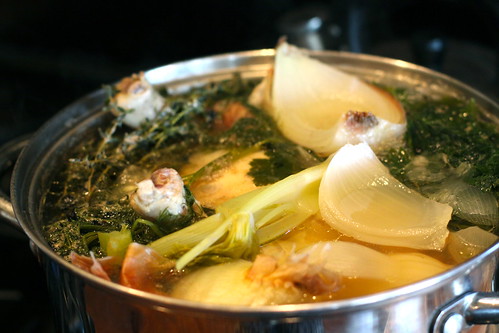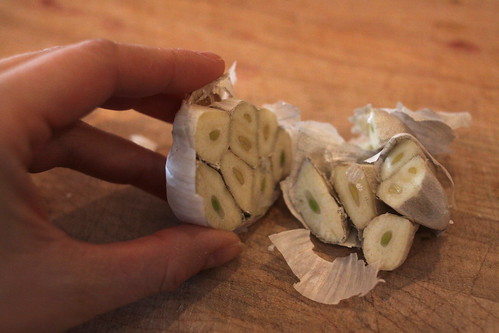Chicken Stock
With all this dental work in our future, I got to thinking about comfort food. There are definitely a lot of foods you can't eat when your mouth is sore. Soup, of course, is always the answer. Me? I'm sort of a soup snob. I much prefer homemade stock to build my soups upon. It always surprises me what a difference it makes in flavor. If you swapped out homemade chicken stock for the store bought variety, and that was the only change you made, your soup would taste more superior by ten fold. Girl Scout promise. And yes, I was a legit girl scout. Troop 538, we are great, 538 the best in the state!
I have tried quite a few recipes for chicken stock and while they were all good, nothing blew my socks off until I tried Ina Gartens. And are you really surprised? That woman is a genius. She jam packs her pot with vegetables and herbs which gives off more flavor. The first time I made this, it looked as if I was going to only be left with the tiniest bit of stock since most of the pot space was already taken up, but the recipe actually yields, on average, enough for two different meals. The second thing is she leaves all her vegetables un-peeled. The onion husk stays on, and same with the garlic which gets one vertical cut to expose the cloves to the water, and no need to peel the carrots or parsnips either which makes prep that much easier. The third difference is she uses fresh dill along with her other herbs. I have never seen that before and I can tell you it might be what single handedly won me over. Dill is absolutely divine in chicken stock-who knew? I would never make it again without using it. It's flavor is light and you might not be able to quite put your finger on what it is, but you know it's awesome.
The only place you can possibly go wrong with chicken stock is if you don't use enough salt. Stock can taste like dirty dishwater without the proper amount of salt, so keep adding as necessary. Ina does provide a near perfect amount in her recipe, but I always taste at the end and see if it could use more. Sometimes it does. Make sure you pick up all the ingredients and don't skimp. It's worth it in the end for maximum flavor. Chicken stock takes a while to simmer, but only takes a couple of minutes to prep and get it going. Then, all thats left is to strain it, chill overnight, and use it all right away, or chances are you'll want to store half in the freezer for another time. You must chill it overnight so that you can remove the fat the next day. When the stock gets cold, the fat rises tot he top making it easy to remove.
You'll need a really large pot for this (a big spaghetti pot will work, but keep in mind, some are bigger than others.) If you don't have one, can't borrow one, and don't want to buy one, you can cut the recipe in half, using half a chicken or a smaller one and using the biggest pot you own, providing it all fits. You won't end up with enough stock for two recipes, but you'll get enough for one.
There we go. Chicken soup for the soul and hopefully teeth as well.
Chicken Stock
adapted from Barefoot Contessa, Family Style, by Ina Garten
Makes about 10 cups
1 5-pound roasting chicken
2 large yellow onions, unpeeled, quartered
2 carrots, unpeeled, halved
2 celery stalks with leaves, cut in thirds
2 parsnips (or sub more carrots) unpeeled, cut in half
12 sprigs fresh parsley
10 sprigs fresh dill
10 sprigs fresh thyme
1 head garlic, unpeeled, cut in half crosswise
1 tablespoon kosher salt (more to taste)
1 teaspoon whole black peppercorns
Place the chicken, onions, carrots, celery, parsnips, parsley, thyme, dill, garlic, and seasonings in a large stockpot. Add 12 cups of fresh water (or more if needed, to cover all the ingredients) and bring to a boil. Simmer uncovered for 4 hours. While cooking, add more water (up to 3 cups total) to the stock after 2 hours, to replace what is evaporated during the cooking process. The chicken and ingredients will rise to the top while cooking. It's okay. I just push everything down once and a while with my spoon. Taste stock for salt and add more if needed.
Strain the entire contents of the pot through a colander and discard the solids. Chill the stock overnight. The next day, remove the surface fat. Use immediately or pack in containers and freeze for up to 3 months.


